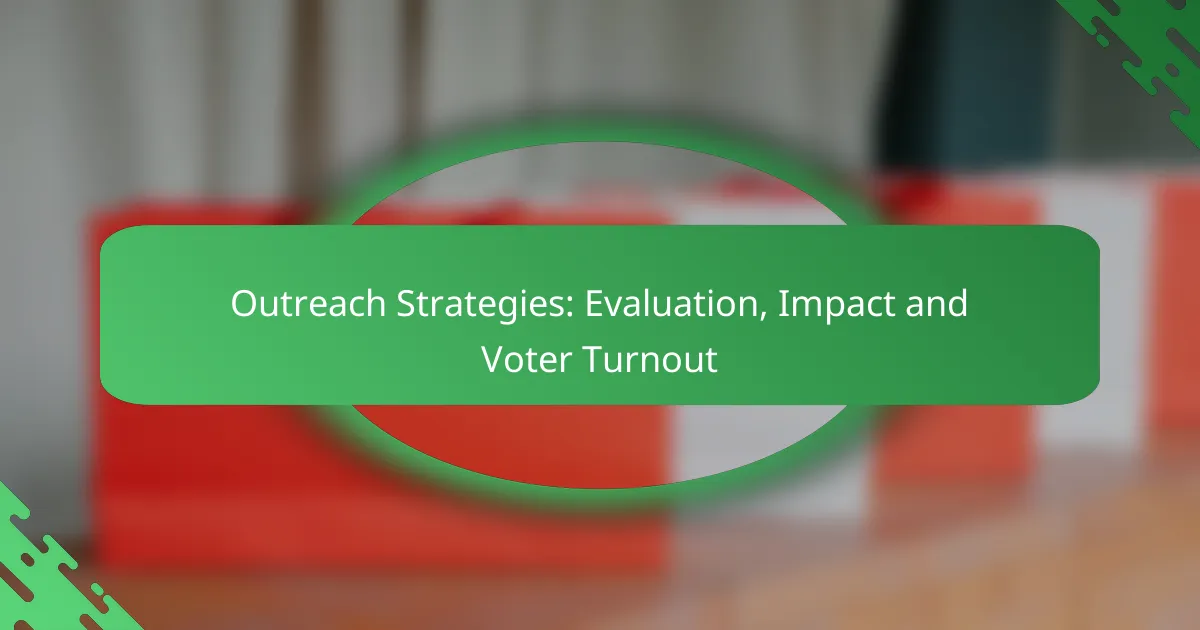Outreach strategies play a crucial role in enhancing voter turnout by engaging citizens through various methods such as door-to-door canvassing, phone banking, and social media campaigns. By informing and motivating voters, these strategies foster greater awareness and participation in the electoral process. Evaluating their effectiveness through metrics like voter turnout rates and engagement levels helps organizations refine their approaches and strengthen community connections.
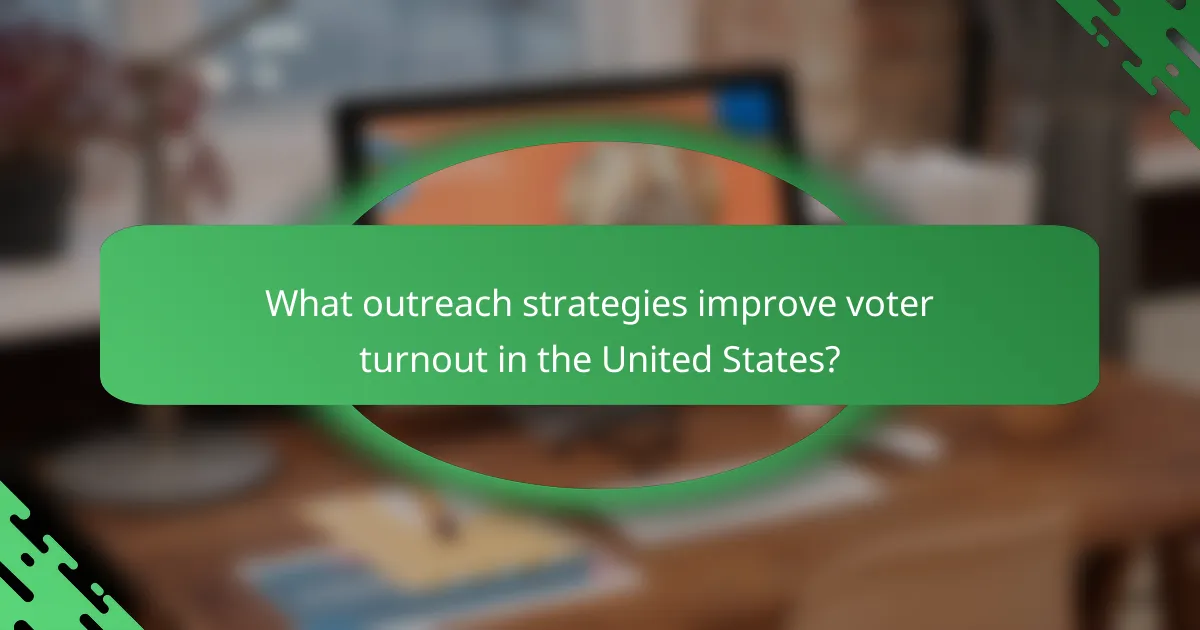
What outreach strategies improve voter turnout in the United States?
Effective outreach strategies that enhance voter turnout in the United States include door-to-door canvassing, phone banking, social media campaigns, community events, and email outreach. Each method engages voters in different ways, aiming to inform and motivate them to participate in elections.
Door-to-door canvassing
Door-to-door canvassing involves volunteers visiting homes to engage directly with potential voters. This personal interaction can significantly influence voter turnout by providing information about candidates and issues while addressing individual concerns.
To maximize effectiveness, canvassers should be well-trained and knowledgeable about local issues. It’s also beneficial to focus on neighborhoods with historically low turnout rates, as targeted efforts can yield higher engagement.
Phone banking
Phone banking is the practice of calling voters to discuss election details and encourage participation. This method allows for direct communication and can be tailored to specific demographics or areas, making it a flexible outreach strategy.
Successful phone banking requires a clear script and a friendly approach. Volunteers should be prepared to answer questions and provide information about polling locations and voting methods to assist voters effectively.
Social media campaigns
Social media campaigns leverage platforms like Facebook, Twitter, and Instagram to reach a broad audience and engage younger voters. These campaigns can include informative posts, live events, and targeted ads to raise awareness about upcoming elections.
To enhance impact, use eye-catching visuals and clear calls to action. Engaging content that resonates with users can encourage shares and discussions, amplifying the outreach effort.
Community events
Hosting community events, such as town halls or voter registration drives, fosters a sense of community and encourages civic engagement. These gatherings provide opportunities for voters to meet candidates and discuss issues that matter to them.
When organizing events, consider partnering with local organizations to increase attendance. Offering incentives, such as food or entertainment, can also draw in larger crowds and facilitate conversations about voting.
Email outreach
Email outreach involves sending targeted messages to inform voters about election dates, candidates, and issues. This strategy can be particularly effective for reaching specific groups and keeping them engaged throughout the election cycle.
To improve response rates, personalize emails and include clear calls to action, such as links to registration or voting information. Regular updates can help maintain interest and remind voters of important deadlines.
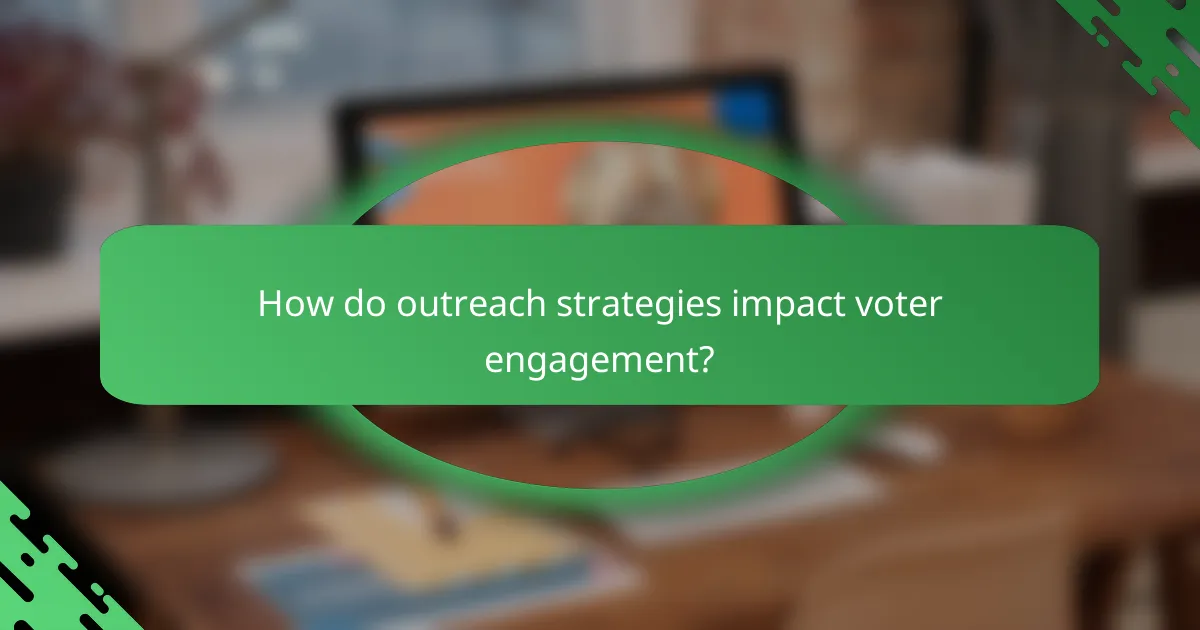
How do outreach strategies impact voter engagement?
Outreach strategies significantly enhance voter engagement by informing citizens about issues and encouraging their participation in the electoral process. Effective outreach can lead to increased awareness, higher participation rates, and stronger community connections.
Increased awareness of issues
Outreach strategies raise awareness of key political and social issues among voters. By utilizing various communication channels, such as social media, community events, and informational campaigns, organizations can effectively disseminate information that resonates with the electorate.
For instance, targeted messaging that highlights local concerns—like education funding or public safety—can engage specific demographics. This approach ensures that voters understand the implications of these issues on their daily lives, fostering a more informed electorate.
Higher likelihood of participation
When voters are informed about issues, they are more likely to participate in elections. Outreach efforts that include reminders about registration deadlines and voting dates can significantly increase turnout, especially among young voters and those from underrepresented communities.
Engagement tactics, such as door-to-door canvassing or phone banking, can also provide personal connections that motivate individuals to vote. Research indicates that personal outreach can boost turnout rates by several percentage points, demonstrating the effectiveness of direct engagement.
Strengthened community ties
Outreach strategies can strengthen community ties by fostering a sense of belonging and collective responsibility among voters. When individuals participate in community discussions and events, they build relationships that encourage civic engagement.
Community-based initiatives, such as town halls or local forums, create opportunities for dialogue and collaboration. These gatherings not only inform voters but also empower them to take action, reinforcing the importance of their voices in the democratic process.

What metrics evaluate the effectiveness of outreach strategies?
To evaluate the effectiveness of outreach strategies, key metrics include voter turnout rates, engagement levels, and feedback surveys. These metrics provide insights into how well outreach efforts resonate with the target audience and their impact on voter participation.
Voter turnout rates
Voter turnout rates are a primary indicator of the effectiveness of outreach strategies. This metric measures the percentage of eligible voters who participate in elections, reflecting how successful outreach efforts are in mobilizing the electorate. For instance, a turnout increase of several percentage points compared to previous elections can indicate effective outreach.
To assess voter turnout, compare data from different elections or demographic groups. Consider factors such as the timing of outreach campaigns and the methods used, as these can significantly influence turnout. For example, targeted mailings or community events may yield higher participation rates than generic advertisements.
Engagement levels
Engagement levels gauge how actively voters interact with outreach efforts, such as attending events, responding to surveys, or engaging on social media. High engagement levels often correlate with increased voter turnout, as they indicate that voters are informed and motivated. Tracking metrics like event attendance or social media interactions can provide valuable insights.
To enhance engagement, tailor outreach strategies to the preferences of the target audience. Utilize platforms that resonate with specific demographics, such as younger voters on social media or older voters through community newsletters. Regularly analyze engagement data to refine strategies and improve outreach effectiveness.
Feedback surveys
Feedback surveys are essential for understanding the perceptions and experiences of voters regarding outreach efforts. These surveys can reveal what aspects of the outreach were effective and what areas need improvement. Collecting feedback through post-event surveys or online questionnaires can provide actionable insights.
When designing feedback surveys, focus on clear, concise questions that address specific outreach elements, such as messaging clarity or event accessibility. Analyzing responses can help identify trends and preferences, allowing for adjustments in future outreach strategies to better meet voter needs.
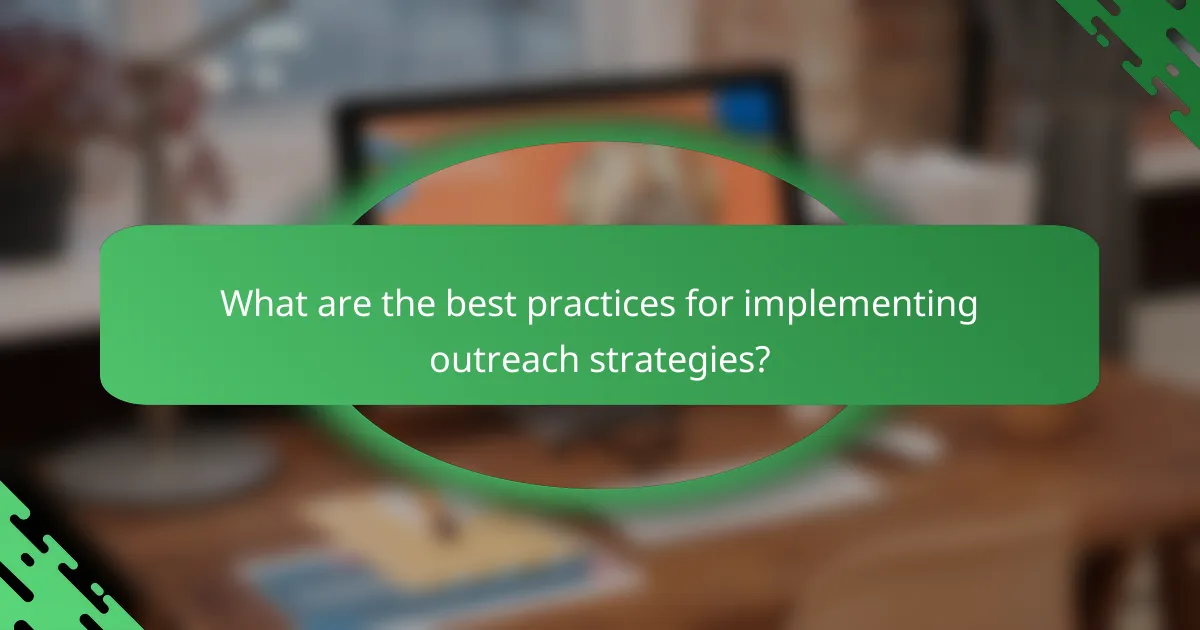
What are the best practices for implementing outreach strategies?
Effective outreach strategies focus on clear communication, targeted engagement, and measurable outcomes. By employing best practices, organizations can enhance their impact and increase voter turnout significantly.
Targeted messaging
Targeted messaging involves crafting communication that resonates with specific demographics or voter groups. This can include tailoring language, themes, and channels to align with the interests and values of the audience.
For instance, using social media platforms popular among younger voters can increase engagement. Similarly, messaging that highlights local issues can be more effective in motivating community members to participate in elections.
Utilizing local influencers
Local influencers can amplify outreach efforts by lending credibility and reaching wider audiences. Collaborating with community leaders, activists, or popular figures can help to spread messages more effectively.
Consider partnering with local organizations or individuals who have a strong following in specific neighborhoods. Their endorsement can significantly enhance trust and encourage voter participation.
Data-driven decision making
Data-driven decision making involves analyzing voter data and outreach metrics to refine strategies. By understanding voter behavior and preferences, organizations can optimize their outreach efforts for better results.
Utilize tools that track engagement rates, demographic responses, and turnout statistics. Regularly reviewing this data can help identify what works and what needs adjustment, ensuring resources are allocated efficiently.
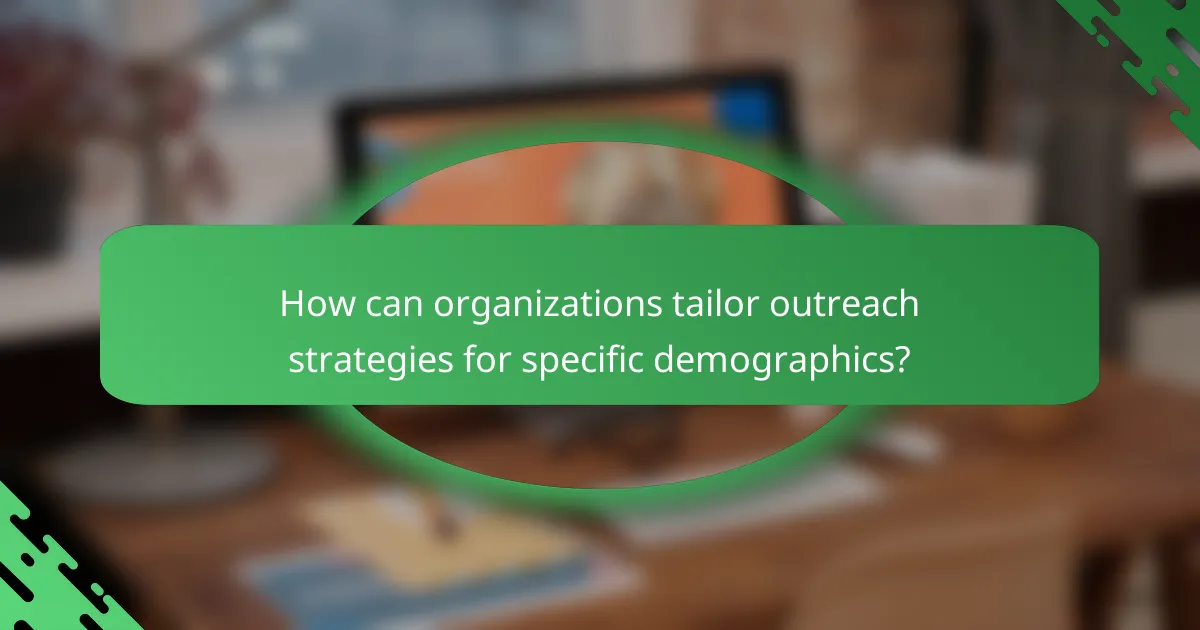
How can organizations tailor outreach strategies for specific demographics?
Organizations can effectively tailor outreach strategies by understanding the unique characteristics and needs of specific demographics. This involves customizing messaging, channels, and engagement methods to resonate with different groups, ultimately enhancing participation and impact.
Understanding cultural contexts
Recognizing cultural contexts is crucial for effective outreach. Different demographics may have distinct values, beliefs, and traditions that influence their engagement with outreach efforts. For example, using culturally relevant symbols or references can make messages more relatable and impactful.
Organizations should conduct research or engage with community leaders to gain insights into cultural norms. This understanding can guide the development of campaigns that respect and reflect the values of the target demographic, fostering trust and connection.
Language accessibility
Language accessibility ensures that outreach materials are understandable to all members of a demographic. This may involve translating materials into multiple languages or using simple, clear language that avoids jargon. Providing resources in the primary languages spoken within a community can significantly increase engagement.
Organizations should consider hiring bilingual staff or collaborating with local translators to enhance communication. Additionally, using visual aids and infographics can help convey messages to those with limited literacy skills, ensuring inclusivity in outreach efforts.
Age-appropriate messaging
Age-appropriate messaging tailors content to the interests and comprehension levels of different age groups. For younger audiences, using social media platforms and interactive content can be effective, while older demographics may prefer traditional media like print or radio.
Organizations should adapt their tone and style based on the target age group. For instance, using humor and vibrant visuals may engage younger voters, while clear and straightforward messaging may resonate better with seniors. Testing different approaches can help identify what works best for each demographic segment.
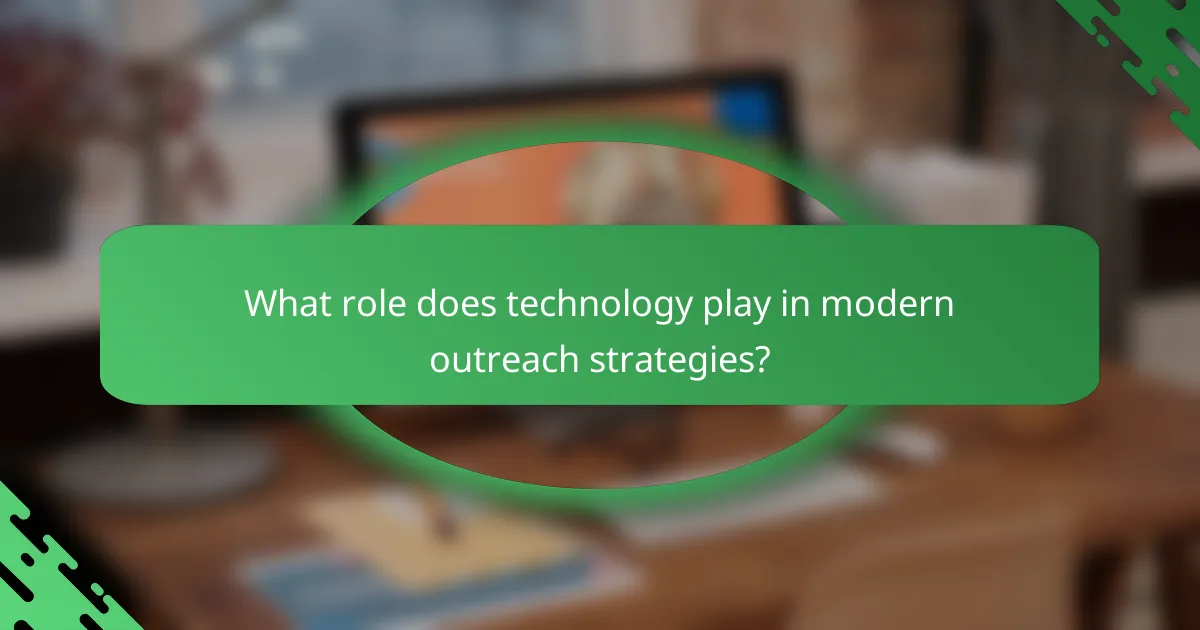
What role does technology play in modern outreach strategies?
Technology is essential in modern outreach strategies, enabling organizations to efficiently connect with their target audiences. It enhances communication, data collection, and analysis, leading to more effective engagement and improved voter turnout.
Data analytics tools
Data analytics tools are crucial for understanding voter behavior and preferences. These tools allow organizations to collect and analyze large volumes of data, helping them identify trends and tailor their outreach efforts accordingly.
By utilizing platforms like Google Analytics or specialized voter engagement software, organizations can track engagement metrics, segment audiences, and optimize their messaging. For instance, analyzing past election data can reveal which demographics are more likely to vote, guiding targeted campaigns.
When implementing data analytics, ensure compliance with data protection regulations, such as GDPR in Europe. Additionally, avoid common pitfalls like over-relying on data without considering qualitative insights, which can provide context that numbers alone may miss.
